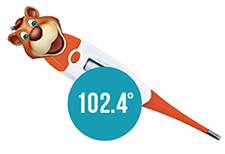
In the May 2016 issue of Annals of Emergency Medicine, ACEP published a clinical policy focusing on fever in young children and infants.1 This is a revision of a 2003 clinical policy related to pediatric fever.
Explore This Issue
ACEP Now: Vol 35 – No 05 – May 2016The 2016 clinical policy can also be found on ACEP’s website, and has been submitted for abstraction on the National Guideline Clearinghouse website.
This clinical policy takes an evidence-based approach to answering four questions frequently encountered when making decisions associated with pediatric fever in the emergency department. Recommendations (Level A, B, or C) for patient management are provided based on the strength of evidence using the Clinical Policies Committee’s well-established methodology:
- Level A recommendations represent patient management principles that reflect a high degree of clinical certainty.
- Level B recommendations represent patient management principles that reflect moderate clinical certainty.
- Level C recommendations represent other patient management strategies based on Class III studies or, in the absence of any adequate published literature, based on consensus of the members of the Clinical Policies Committee.
During development, this clinical policy was reviewed and comments were received from emergency physicians; members of the American Academy of Pediatrics, American Academy of Family Physicians, and ACEP’s Pediatric Emergency Medicine Committee; and those health care providers responding to the notice of the open comment period. All responses were used to further refine and enhance this policy. However, responses did not imply endorsement of this clinical policy.
This revision of the clinical policy for well-appearing infants and children 2 months to 2 years of age (29 days to 90 days for meningitis) presenting with fever was prompted by advances in diagnostic technology, the changing epidemiology, and incidences of the various infections comprising a serious bacterial infection, along with input from ACEP members, which led to four critical questions.
Critical Questions and Recommendations
 Question 1. For well-appearing immunocompetent infants and children aged 2 months to 2 years presenting with fever (>38.0°C [100.4°F]), are there clinical predictors that identify patients at risk for urinary tract infection?
Question 1. For well-appearing immunocompetent infants and children aged 2 months to 2 years presenting with fever (>38.0°C [100.4°F]), are there clinical predictors that identify patients at risk for urinary tract infection?
Patient Management Recommendations
Level A recommendations: None specified.
Level B recommendations: None specified.
Level C recommendations: Infants and children at increased risk for urinary tract infection include females younger than 12 months, uncircumcised males, nonblack race, fever duration greater than 24 hours, higher fever (≥39°C), negative test result for respiratory pathogens, and no obvious source of infection. Although the presence of a viral infection decreases the risk, no clinical feature has been shown to effectively exclude urinary tract infection. Physicians should consider urinalysis and urine culture testing to identify urinary tract infection in well-appearing infants and children aged 2 months to 2 years with a fever ≥38°C (100.4°F), especially among those at higher risk for urinary tract infection.
Pages: 1 2 3 4 | Single Page

 ACEP Now features one article each issue related to an ACEP eCME CME activity.
ACEP Now features one article each issue related to an ACEP eCME CME activity.



No Responses to “Evaluating Fever in Well-Appearing Infants and Children”